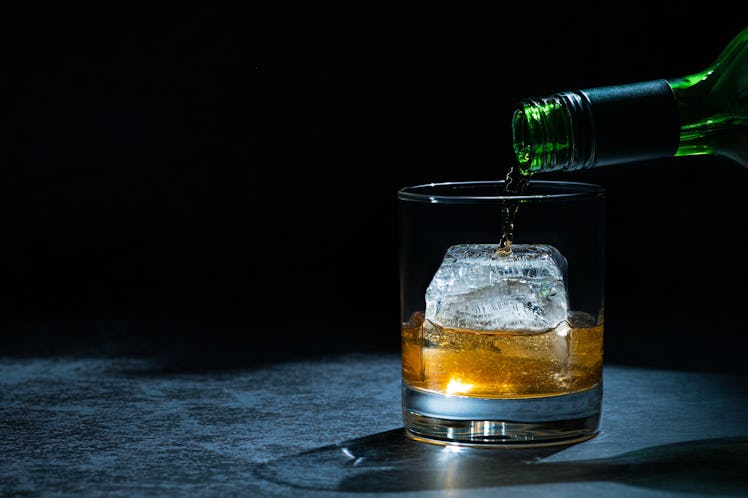This Is The Perfect Amount Of Water To Add To Your Whiskey
Thanks, science.

Does adding water actually improve your whiskey? It’s common knowledge that a splash can enhance the notes of a bourbon or Scotch. But add too much, whether from melting ice cubes or a tap, and you risk over-diluting — and thus ruining — your drink. So what is the ideal amount of water to add, if any?
A team of curious researchers at Washington State University recently published the results of a study that attempted an answer. And they claim to have figured out the perfect water-to-whiskey ratio for maximum flavor.
The team of researchers chemically analyzed how volatile compounds in 25 whiskies changed when water was added to them. The bottles they analyzed included blended Irish whiskeys, bourbons, ryes, and both blended and single malt scotches, with varying degrees of water added for dilution.
A sensory panel was then tasked with assessing the smell of a smaller group of the whiskeys, both when they were poured straight from the bottle and through varying degrees of dilution.
Both tests found that adding a little water does change the smell of the whiskies, and that when each tested whisky was fully undiluted, “the panelists could easily tell all the whiskies apart from each other.”
They also found that a dilution level of 20% — that is, 20% water and 80% whiskey — makes it much more challenging to tell the different whiskies apart.
But that doesn’t mean you won’t know what you’re drinking altogether. When the drinks were more diluted, although the scents became more similar within each “type” of whisky, researchers noted that “the larger group of Scotches, both single malts and blended, remained distinct from the American bourbons and ryes.”
All the same, if you’re a whiskey purist — and if you simply want to enjoy your whiskey of choice as purely as possible — less diluted appears to be the way to go.
“If you want to enjoy a specific whisky, this suggests that you don’t want to dilute it by more than about 20%,” said Tom Collins, a Washington State University assistant professor and senior author of the study, which published in the journal Foods. “By the time you get to 60/40 whisky to water, the whiskies are not differentiated by the panelists; they begin to smell the same, and that’s not really what you’re looking for.”
The findings also shed light on the trend of serving whiskey with one single, oversized ice cube. They’ve become so popular, “because you can actually enjoy the whisky before it gets diluted to the point that it’s not the same whisky,” Collins added. Large ice cubes melt slower than smaller ones.
But why is 80/20 the perfect ratio of whiskey to water? That has all to do with how whisky is made up, chemically. The researchers note that “whisky is a mix of compounds that run the scale from hydrophilic to hydrophobic.” If that sounds like gaga to you, its simple — hydrophilic compounds are attracted to water; hydrophobic compounds repel it. Whiskey changes when water is added to it because of how the water molecules interact with the hydrophobic compounds, which can change the aroma of the whisky and therefore the taste.
As for what this research means for the future, researchers hope that this will help whisky manufacturers understand their product more and will continue to look into why Scotch, in particular, has its “smoky aroma.”
In the meantime, happy drinking.